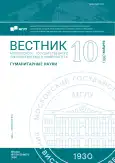EXPRESSING AGGRESSION THROUGH EMOJI (BASED ON INTERNET COMMENTS)
- 作者: Katermina V.V.1, Vulfovich B.G.1
-
隶属关系:
- Kuban State University
- 期: 编号 10(891) (2024)
- 页面: 68-74
- 栏目: Linguistics
- URL: https://journal-vniispk.ru/2542-2197/article/view/293063
- ID: 293063
如何引用文章
全文:
详细
The purpose of the article is to analyze comments of an aggressive nature from the point of view of the emoji used in them taking into account both the context of such a comment and its social and public significance as well as the potential resonance that it can create in society. The relevance and novelty of the article are due to the fact that the sphere of emoji is not often found in linguistic research today, however, since from the standpoint of semiotics, a “smiley” is a sign containing certain linguopragmatic information, this sphere certainly generates interest for its further research.
关键词
作者简介
Veronika Katermina
Kuban State University
编辑信件的主要联系方式.
Email: katermina_v@mail.ru
Doctor of Philology (Dr. habil), Professor, Professor at the Department of English Philology Kuban State University
俄罗斯联邦Boris Vulfovich
Kuban State University
Email: justb8888@gmail.com
PhD (Philology), Associate Prof. at the Department of English Philology Kuban State University
俄罗斯联邦参考
- Balyasnikova, O. V. (2015). Opyt psikholingvisticheskogo issledovaniya znacheniya odnogo iz klyuchevykh slov konfliktogennogo teksta [Journalism – medialogy – mentoring]. Vestnik Novosibirskogo gos. unta. Seriya: Lingvistika i mezhkul'turnaya kommunikatsiya [Bulletin of the Novosibirsk State. unta. Series: Linguistics and Intercultural Communication], 13(4), 22–27. (In Russ.)
- Voroshilova, M. B. (2013). Kreolizovannyy tekst: printsip tselostnosti ili printsip zamenyaemosti [Creolized text: principle of integrity or principle of replaceability]. Politicheskaya lingvistika [Political linguistics], 4(46), 177–183. (In Russ.)
- Golev, N. D. (2002). Pravovoe regulirovanie rechevykh konfliktov i yurislingvisticheskaya ekspertiza konfliktogennykh tekstov [Legal regulation of speech conflicts and legal linguistic examination of conflict-prone texts]. Pravovaya reforma v Rossiyskoy Federatsii: obshcheteoreticheskie i istoricheskie aspekty [Modern philology: current problems, theory and practice] (pp. 110–123). Barnaul. (In Russ.)
- Golev, N. D. (2007). Yurislingvistika i lingvokonfliktologiya (k tipologii yazykovykh konfliktov) [Jurislinguistics and linguistic conflictology (towards the typology of language conflicts)]. Sovremennaya filologiya: aktual'nye problemy, teoriya i praktika [Modern philology: current problems, theory and practice] (pp. 20–30). Krasnoyarsk. (In Russ.)
- Kim, G. V. (2017). Priznaki otdel'nykh vidov konfliktogennogo teksta (na primere materialov regional'noy sudebnoy praktiki) [Signs of certain types of conflict-prone text (based on the example of materials from regional judicial practice)]. Sovremennye problemy lingvistiki i metodiki prepodavaniya russkogo yazyka v vuze i shkole [Modern problems of linguistics and methods of teaching the Russian language at universities and schools], 27, 100–103. (In Russ.)
- Makarenko, G. S. (2016). Eksplitsitnye i implitsitnye markery konfliktogennosti publitsisticheskogo teksta [Explicit and implicit markers of conflict potential of a journalistic text]. Vestnik Bashkirskogo universiteta [Bulletin of Bashkir University], 1(21), 192–195. (In Russ.)
- Makhina, L. A. (2016). Vyskazyvaniya s negativnoy otsenochnost'yu kak elementy struktury i smysla konfliktogennykh tekstov [Statements with negative evaluation as elements of the structure and meaning of conflict-generating texts]. Litera, 4, 1–10. (In Russ.)
- Guseinova, I. A., Gorozhanov, A. I. (2023). Connotated image as a way of constructing informational opposition in the fictional and publicistic genre. J. Sib. Fed. Univ. Humanit. soc. sci., 16(6), 911–920. (In Russ.)
- Akhrenova, N. A., Zaripov, R. I. (2023). Linguopragmatic Scopes of Modern Media Texts. Vestnik Rossiyskogo universiteta druzhby narodov. Seriya: Teoriya yazyka. Semiotika. Semantika, 14(3), 801–817.
- Burton, J. W. (1990). Conflict: Resolution and Prevention.
- Malyuga, E. N., Orlova, S. N. (2018). Linguistic pragmatics of intercultural professional and business communication (Springer).
- Babuk, A. V. (2023). Emotikony i emodzi v internet-kommunikatsii = Emoticons and emojis in Internet communication. Journalism – medialogy – mentoring]: materialy mezhdunar. Nauch.-prakt. Konf., posvyashch. Pamyati B. V. Strel'tsova, Minsk. (In Russ.)
- Girutskiy, A. A. (2017). Obshchee yazykoznanie = General linguistics. Minsk: Vyshjejshaja shkola. (In Russ.)
- Galyashina, E. I. (2022). Semiotika emotikonov i animatsionnykh kartinok v aspekte sudebnoy lingvisticheskoy ekspertizy = Semiotics of emoticons and animated pictures in the aspect of forensic linguistic examination. Bulletin of the University named after O. E. Kutafina (MSAL), 2, 42–48. (In Russ.)
- Danesi, M. (2017). The semiotics of emoji: The rise of visual language in the age of the internet (pp. 75–78). London: Bloomsbury Academic.
- Babuk, A. V. (2023). Semiotika emodzi i vyyavlenie verbal'noy ugrozy v tekstakh internet-kommunikatsii pri provedenii sudebnoy lingvisticheskoy ekspertizy v respublike Belarus' = Semiotics of emoji and identification of verbal threat in Internet communication texts during forensic linguistic examination in the Republic of Belarus. Modern media text and forensic examination: interdisciplinary connections and expert assessment. Moskva, 12–13 oktyabrya, 16–33. (In Russ.)
补充文件










